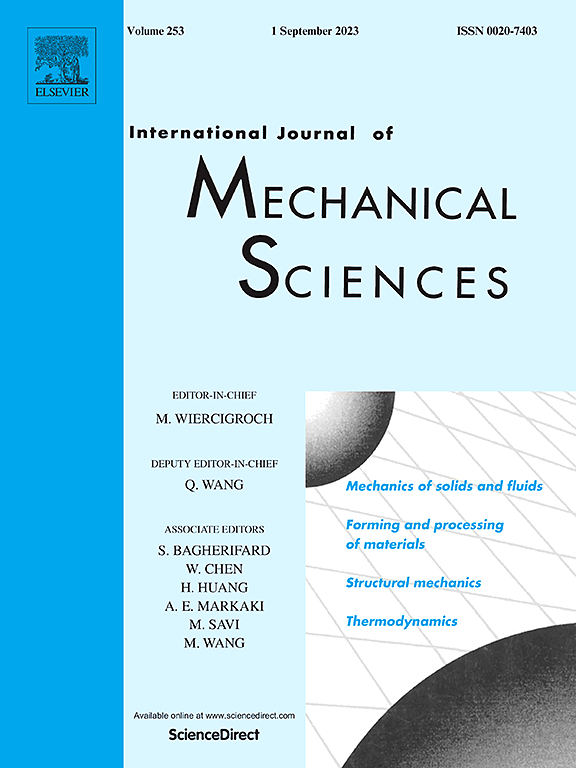Topography measurement-integrated non-immersion CRECM: Process design and experimental investigation
IF 7.1
1区 工程技术
Q1 ENGINEERING, MECHANICAL
International Journal of Mechanical Sciences
Pub Date : 2025-07-15
DOI:10.1016/j.ijmecsci.2025.110607
引用次数: 0
Abstract
Counter-rotating electrochemical machining (CRECM) offers significant advantages for manufacturing large thin-walled rotary components. However, conventional immersed flow fields face critical challenges such as byproduct accumulation, uncontrollable stray corrosion, and the absence of real-time monitoring. To address these issues, this study is the first to propose a non-immersion flow field process for CRECM, integrated with an topography measurement system for real-time monitoring. The optimized flow field design overcomes the limitations of conventional configurations and creates favorable conditions for in-situ process control. Flow field simulation and experimental results show that the dual-side alternating electrolyte supply mode achieves the best performance, with a surface roughness of 1.2 μm, a material removal rate of 6.14 cm³/min, and reduced rib symmetry deviation from 0.13 mm to 0.02 mm. The integrated topography measurement system provides real-time monitoring of surface profiles and corrosion depth d, facilitating mechanism analysis, early detection of deviations, and minimizing errors caused by offline inspection and re-clamping. Monitoring results reveal that rib asymmetry becomes significant under single-side electrolyte supply when rib height exceeds 0.5 mm.This synergy effectively resolves the long-standing challenge of "blind machining–passive scrapping" and provides a viable solution for high-efficiency, high-precision machining of rotary components.

地形测量集成非浸没CRECM:工艺设计与实验研究
反向旋转电化学加工(CRECM)为制造大型薄壁旋转部件提供了显著的优势。然而,传统的浸入式流场面临着诸如副产品积累、不可控的杂散腐蚀以及缺乏实时监测等严峻挑战。为了解决这些问题,本研究首次提出了用于CRECM的非浸没流场过程,并集成了用于实时监测的地形测量系统。优化后的流场设计克服了常规配置的局限性,为现场过程控制创造了有利条件。流场模拟和实验结果表明,双面交变电解液供电方式性能最佳,表面粗糙度为1.2 μm,材料去除率为6.14 cm³/min,肋对称偏差从0.13 mm减小到0.02 mm。集成的形貌测量系统可实时监测表面轮廓和腐蚀深度,便于机理分析,早期发现偏差,最大限度地减少离线检查和重新夹紧造成的误差。监测结果表明,当肋高超过0.5 mm时,在单侧电解液供应下,肋的不对称性变得明显,有效地解决了长期存在的“盲目加工-被动废弃”难题,为旋转部件的高效、高精度加工提供了可行的解决方案。
本文章由计算机程序翻译,如有差异,请以英文原文为准。
求助全文
约1分钟内获得全文
求助全文
来源期刊

International Journal of Mechanical Sciences
工程技术-工程:机械
CiteScore
12.80
自引率
17.80%
发文量
769
审稿时长
19 days
期刊介绍:
The International Journal of Mechanical Sciences (IJMS) serves as a global platform for the publication and dissemination of original research that contributes to a deeper scientific understanding of the fundamental disciplines within mechanical, civil, and material engineering.
The primary focus of IJMS is to showcase innovative and ground-breaking work that utilizes analytical and computational modeling techniques, such as Finite Element Method (FEM), Boundary Element Method (BEM), and mesh-free methods, among others. These modeling methods are applied to diverse fields including rigid-body mechanics (e.g., dynamics, vibration, stability), structural mechanics, metal forming, advanced materials (e.g., metals, composites, cellular, smart) behavior and applications, impact mechanics, strain localization, and other nonlinear effects (e.g., large deflections, plasticity, fracture).
Additionally, IJMS covers the realms of fluid mechanics (both external and internal flows), tribology, thermodynamics, and materials processing. These subjects collectively form the core of the journal's content.
In summary, IJMS provides a prestigious platform for researchers to present their original contributions, shedding light on analytical and computational modeling methods in various areas of mechanical engineering, as well as exploring the behavior and application of advanced materials, fluid mechanics, thermodynamics, and materials processing.
 求助内容:
求助内容: 应助结果提醒方式:
应助结果提醒方式:


